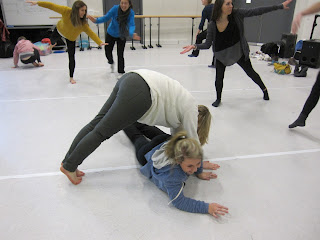Lecturer: Jacqui Dressens
We began the workshop by reviewing last week's performances. We needed to share with someone how we felt. We discussed working with team members, out of the ordinary, no formal presentation was good without an audience as we were altogether, the music helped, the timing was uncertain.
With Drama and Dance, children may love/hate improvisation. This is why it needs to be structured as it has a clear intention and they can 'freeze' on fear of now knowing what to do but are able to rely on the group. This should be done in a problem solving method as it is a creative process.
Tip: Don't force students to perform if they are disinterested or scared (especially if in a state of terror) as they will hate dance.
Dance is a movement text/language, therefore a form of literacy. We must teach students to read movement language and respond to it: to harness shapes moving in space, harness movement qualities changing.
As a teacher set your lessons up to prepare students for a task (so they will be ready). Be inclusive in teaching.
Questions for preps about presentations: (Keep it open ended- HOW)
- How are they moving in the space? (Expand, contract, high/low)
- How does their movement change?
- How did they use their time? (Fast slow, flowing, stilted/ bound, dynamics- sustained, suspended, swinging, repetition, extended or short)
We each shared one question per performance in our groups.
1. How does their movement change?
2. When did they all travel at the same time?
3. When did they speed up/slow down? Why? (Animal instinct of flight/fight response)
4. Why doe their hands vibrate? (Fuction and structure of fish)
5. Can you describe the different body movements that you see?
6. What body parts are moving? How? (Anatomy)
7. How did the variation of timing help tell the story? What was happening when they were fast/slow? Where could they be?
8. Why did they start moving in different directions?
9. Why did they move across the space? How did the movement change as they moved?
We then drew a floor plan of our performances and a drawing of body movements using lines (flowy/smooth/zigzag).
Then we wrote a short narrative describing our performances: 6 fish were swimming together. Suddenly a shark startled them and they separated to hide. They reunited again when the shark went away and began to slowly swim about again.
Then we started moving!
After moving in the space, we followed Jacqui into a line which became a circle.
We learnt and created a canon where a movement is repeated from one person to the next in a sequential movement. This movement is mimicked from one person to the next. This happens quickly and fluently like a wave. Retrograde meant we would change direction of the canon to go the opposite way.
In groups we played a game where we could only have a certain number of body parts touching the floor. We all needed to also be connected in some way.
We then practiced 'Mirror, Mould, Extend' in groups of three.
Mirror- reflect someone's movement
Mould- create a body position around someone
Extend- building on someone's shape
Using coloured scarves, we mirrored, molded and extended as a whole class group creating a large shape looking like a tree.
Half the class was then blindfolded and lead around the room in different paces and levels. This proved a very challenging task as people constantly bumped into each other or barely dodging one another.
Teaching Implications
At level 4, students ‘learn about ways to design,
improvise, represent, interpret, make and present arts works that communicate
feelings and their interests and understanding of themselves, their
relationships and other people. For example: in Dance, students mirror the
movements of a partner and then perform the same movements expressing
contrasting emotions’ (VCAA, 2009). 'Mirror, mould, extend' is a simple and effective way for students to begin moving their bodies in different shapes comfortably. It is inclusive as every person must take turns to build and be built on in terms of their body shape. They are able to represent relationships this way as they work with one another showing how each individual can be different but can contrast or build upon each other's actions/strengths/shape.
'Students learn to evaluate
their own and other people’s arts works showing some understanding of selected
arts forms and their particular techniques and processes. Through exploring and
responding, students begin to develop a vocabulary of appropriate arts language they can use to describe and discuss the content and
structural qualities of their own and other people’s arts works.’(VCAA, 2009)'. Reflection on performances is essential as it develops students' understanding of dance concepts and draws them to focus and discuss these techniques and aspects as they continue to learn how dance is used to express/represent many things in the world around us. Most importantly, they are able to discuss how this done through their choice of movements as most of this may be done unconsciously as we dance. Reflection and evaluation is important to develop further understanding build on improvement in future dances.
References
Dance photos Workshop 1 2012, Deakin University Burwood Dance Discussion Forum, DSO
Victorian Curriculum and Asessment Authority 2009, 'The Arts- Level 4' <http://vels.vcaa.vic.edu.au/vels/arts.html>
Dance photos Workshop 1 2012, Deakin University Burwood Dance Discussion Forum, DSO
Victorian Curriculum and Asessment Authority 2009, 'The Arts- Level 4' <http://vels.vcaa.vic.edu.au/vels/arts.html>








No comments:
Post a Comment